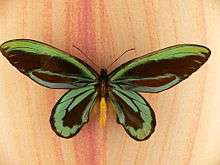Insect biodiversity
Insect biodiversity accounts for a large proportion of all biodiversity on the planet—over half of the estimated 1.5 million organism species described are classified as insects.[1][2]

Number of species
Over 900,000 species of insects have been described;[2] current estimates of total insect diversity varies from 2.6 - 7.8 million species with a mean of 5.5 million.[3] Beetles (Coleoptera) make up 40% of described insect species, but some entomologists suggest that flies (Diptera) and Hymenoptera (wasps, bees and ants) could be as diverse or more so. Five orders of insects stand out in their levels of species richness: Hymenoptera, Diptera, Coleoptera, Lepidoptera, and Hemiptera. A recent study estimated the number of beetle species at 0.9-2.1 million with a mean of 1.5 million.[3]
Conservation

While biodiversity loss is a global problem, conserving habitat for species of insects is uncommon and generally of low priority, although there are exceptions. More commonly insect conservation occurs indirectly, either through the setting aside of large portions of land using "wilderness preservation" as the motive, or through protection of "charismatic vertebrates".
Single-species insect conservation can preserve other species indirectly; this preservation-by-default is referred to as the umbrella effect. Showy insects such as butterflies or large, colourful beetles serve as flagship species, and can expand public awareness and financial contributions for conservation efforts. Wealthy nations such as the United States do list species of concern, and occasionally insects are placed on its Endangered Species List. In 2017 this list had classified over 80 insects as endangered species, the majority of them beetles or butterflies; a significant percentage of these listed insects are native only to the Hawaiian Islands.[4] Migratory species, such as the well-known monarch butterfly (Danaus plexippus), are in need of special conservation methods. One species may require several habitat locations, even across international boundaries, for the different periods of their migratory patterns.
Insect conservation has been labelled in the past as a concern only for the affluent. The developing country of Papua New Guinea has a "happily ever after" ending in their attempts to preserve the world's largest butterfly, Queen Alexandra's birdwing (Ornithoptera alexandrae). This species is restricted to a very small range of habitat due to specificity in their diet. In the international market of insect collecting, the butterfly can retrieve up to US$2000. In 1978, the government of Papua New Guinea set up the Insect Farming and Trading Agency (IFTA) to regulate the exploitation and conservation of Queen Alexandra's birdwing and other valuable butterflies.
Agriculture
In agricultural ecosystems, biodiversity is instrumentally important not only for the production of food, but for other ecological services as well, including the recycling of nutrients, regulation of microclimate and local hydrological processes, suppression of undesirable organisms and detoxification of noxious chemicals.
In the United States alone, pollination by bees accounts for over US$9 billion of economic revenue.[5] According to some estimates, over ⅓ of the human diet can be traced directly or indirectly to bee pollination.[6] Losses of key pollinators have been reported in at least one region or country on every continent except Antarctica, which has no pollinators. The Millennium Ecosystem Assessment [7] concluded that with the global decline in the amount of pollinators, there is not a complete loss of fruit or seeds, but a significant decrease in quantity and viability in fruits, and a lower number of seeds.
Food (human)
Insects are a nutritional source for much of the animal world. Among humans, over 1000 species of insects have been used as food somewhere in the world. Entomophagy is common in central and southern Africa, Asia, Australia, and Latin America. Termites, crickets, grasshoppers, locusts, beetles, ants, bee brood, and moth larvae are examples of insects that are used as food sources. Insects are high in protein, energy, and a number of minerals and vitamins and can form up to 5-10% of the annual animal protein consumption of certain indigenous groups .[8] Many insects are said to have a nutty flavour, along with a high nutritional content.
Human culture
Early human civilisations held insects as an important element within their cultures. Most famously, scarab beetles were central religious artifacts within Egyptian culture. Insect symbolism, such as the dung beetle portrayed as a potter, is seen in the East as well. The Chinese viewed cicadas as a symbol of birth or immortality, the San of the Kalahari believe that the praying mantis represents creation and patience, and the Greeks also created beautiful representations of scarab beetles using colourful stones.
See also
References
- ↑ N. E. Stork, J. McBroom, C. Gely, and A. J. Hamilton (16 June 2015). "New approaches narrow global species estimates for beetles, insects, and terrestrial arthropods" (PDF). PNAS. 112 (24): 7519–7523. doi:10.1073/pnas.1502408112. PMC 4475949. Retrieved 21 September 2017.
- 1 2 Smithsonian. "Numbers of Insects (Species and Individuals)". BugInfo. Smithsonian Institution. Retrieved 21 September 2017.
- 1 2 Stork, N. E.; McBroom, J; Gely, C; Hamilton, A. J. (2015). "New approaches narrow global species estimates for beetles, insects, and terrestrial arthropods". Proceedings of the National Academy of Sciences. 112: 201502408. doi:10.1073/pnas.1502408112. PMC 4475949. PMID 26034274.
- ↑ US Fish and Wildlife Service. "Conserving the Nature of America". ECOS Environmental Conservation Online System. US Fish and Wildlife Service. Retrieved 21 September 2017.
- ↑ W. S. Robinson, R. Nowogrodski & R. A. Morse. (1989). "Pollination parameters". Gleanings in Bee Culture. 117: 148–152.
- ↑ S. E. McGregor (1976). Insect pollination of cultivated crop plants. USDA Agriculture Handbook 496, Washington, D.C.
- ↑ Millennium Ecosystem Assessment, 2005. Ecosystems and Human Well-being: Biodiversity Synthesis. World Resources Institute, Washington, D. C.
- ↑ P. S. Cranston & P. J. Gullan (2005). The Insects: An Outline of Entomology. Blackwell, Oxford. ISBN 1-4051-1113-5.